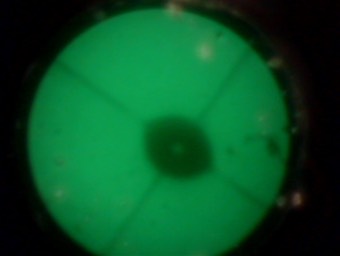
The research in our lab focuses around nanomechanics, and often nanomechanics at low temperatures. A prototypical device is shown at the right. This is a simple cantilever just four microns long and 220 nanometers thick with an effective mass of only 240 femtograms. With such a small mass, a nanomechanical cantilever can be an exquisite force sensor if combined with proper calibration. Similarly, we have developed torsional devices for torque sensing.
A key feature of nanomechanics is the ability to measure the mechanical displacement with extreme sensitivity. We use optomechanics, which means the measurment is enhanced through an overlap of the mechanical motion with an optical cavity. In particular we specialize in dimpled tapered fiber measurements of whispering gallery mode resonators. This is a powerful technique that promises to enable nanomechanical measurements down to their quantum limit.
While force sensors work best in their linear regime, in a non-linear regime nanomechanical resonators may be useful for quantum measurements. Measurement of the discrete nature of phonons in a nanomechancial resonator is one of the three biggest goals of our lab.
To make a quantum measurement of a nanomechancial resonator we not only need good nanofabrication and a quantum measurement protocol, but also low temperature capabilities. Thus we have spent considerable effort building an optomechancial measurement system that runs on the base plate of a dilution refridgerator, seen in the second image on the right. It allows full control of the coupling to an optical resonator with a base temperature of 9 mK. This is enabled by a low-temperature endoscope, and an image through this microscope is seen in the third image on the right.
Another major effort in our group is the use of nanofabrication to precisely confine superfluids and observe new physics as a result. This includes acoustic measurements, as well as nanomechanical measurements through a Helmholtz resonance coupled to the dielectric constant. One particularly exciting consequence of the latter is the ability to measure the superfluid density in a tiny volume, seen in the fourth image on the right. Extending these measurements to superfluid 3He could lead to a direct signature of Majorana fermions in 3He-B, the second of the big goals of our lab.